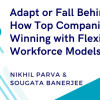How Digital World-Class Procurement Organizations Outperform Peers
By Laura Gibbons, Senior Research Director, and Christopher Sawchuk, Principal and Global Procurement Advisory Practice Leader at The Hackett Group.
The best-performing procurement organizations traditionally operate at a lower cost than typical procurement organizations (i.e., peers), while also providing greater strategic value and overall effectiveness.
According to The Hackett Group’s latest Digital World-Class Procurement Research, the cost gap between the world class and peers has widened slightly over the past decade. But in 2021, a new bar has been set by digital world-class procurement organizations, which spend 25% less than typical procurement organizations, and 6% less than even world-class.
For decades, The Hackett Group has benchmarked and analyzed the performance of major business functions, including procurement, using empirical data and a proprietary methodology to understand what drives world-class performance.
Because digital trends are increasingly linked to superior performance, we updated our methodology in 2021 to add a greater weight to automation and experience benchmarks. We refer to this new bar as “digital world class.” Digital world-class procurement organizations are those that perform in the top decile in both operational excellence and business value.
Digital World-Class Procurement Organizations Create More Value
Digital world-class procurement organizations demonstrate their operational excellence primarily in the form of greater efficiency. In 2021, they run at a 25% lower cost than peers, despite spending more on technology. For a $10 billion company, this represents a cost savings of $6.9 million. Digital world-class procurement organizations also employ 33% fewer full-time equivalents (FTEs) than peers per billion dollars of revenue. The gap is even greater for operations and compliance management FTEs (57%), enabling these organizations to deliver those processes at 55% lower cost.
But the digital world-class advantage is not just about cost. They are also able to deliver greater business value in the form of higher-quality services – better stakeholder engagement, supplier relationship management and product innovation. Compared to peers, they have 2.5-times higher procurement return on investment and 25% more spend influenced or managed by procurement.
Their greater business value is reflected in stakeholder experience, where they have a performance edge in customer perceptions around value and agility. They are 85% more likely to be viewed by stakeholders as taking a proactive approach to supply risk mitigation and 19% more likely to be considered a valued business partner. In addition, they are nearly 7 times more likely to be viewed as having effective business knowledge skills.
Here's How They Do It
Technology, of course, plays a key role in their efficiency and effectiveness. Digital world-class procurement organizations spend 20% more than peers on technology as a percentage of spend. They invest in emerging technologies such as smart automation, advanced analytics and collaboration tools to reduce labor costs. They also automate more activity than peers – in some cases, reaching maximum automation levels.
For example, they have fully automated dissemination of purchase orders to suppliers, and they process 100% of requisitions electronically. By comparison, peers automate only 70% of purchase orders and process only 67% of requisitions electronically.
They also automate knowledge processes to help their staff add more value. For example, 68% of organizations currently have self-service portals or networks, with an expected increase of 21% during this year.
As procurement functions automate more and more of their work, opportunities to improve efficiency decline. This requires finding other opportunities across the procurement service delivery model to close the gap to top performance. Therefore, our digital world-class and other research looks at how procurement organizations are evolving their operations in areas such as data and analytics, modern architecture, operating model transformation and talent.
Sophisticated procurement organizations are quick to embrace new data and analytics techniques, such as predictive modeling. In our 2021 Key Issues Study, 33% of procurement respondents reporting having large-scale deployments of data visualization tools. Additionally, 86% and 77% of services organizations and manufacturing organizations, respectively, are expanding or planning to expand data sources for risk data and supply/market intelligence.
Modern architecture is key to tackling the complexity in today’s operations. Not surprisingly, our 2021 Key Issues Study projects 31% year-on-year growth in adoption of cloud-based core procurement application suites, and most procurement best-of-breed applications are now deployed in the cloud.
Our study of digital world-class functions found that these organizations have been able to modernize architecture more rapidly than peers because they have established clear process ownership and responsibility, as well as effective partnerships with internal technology groups.
Digital world-class procurement organizations are also evolving their operating model to create a more fluid network of resources that can be deployed quickly to support the highest-value activities. This requires moving from a model where resources primarily are under the control of the chief procurement officer to a hybrid model of both functional and enterprise resources.
In fact, we project that in this future model, 53% of procurement resources will be in digital operations, transformation execution and enterprise capability centers that serve the company across functions (i.e., are enterprise aligned). By comparison, only 14% of procurement resources are aligned in such a way today.
Top-performing procurement organizations are more likely to have dedicated global process owners who can spot bottlenecks and make changes more easily. Today, 70% of companies have a single process ownership over the source-to-pay or purchase-to-pay processes – an increase over prior years.
Finally, procurement leaders reinvest some of their efficiency gains in the talent necessary to perform more strategic, knowledge-centric work. For example, digital world-class procurement organizations have 70% more staff in product design and development roles than peers, and 15% more in supplier partnering. They also provide 2.4 times more training hours for their workforce than peers do.
Learn From the Leaders
Most procurement organizations are still far from achieving digital world-class performance levels – thus, they have plenty of opportunity to improve by addressing some of the areas above. But rather than targeting incremental changes, procurement executives should focus on accelerating digital transformation and moving toward an operating model that is designed specifically to perform at a digital world-class level. Understanding how the best have done that is a good place to start.









